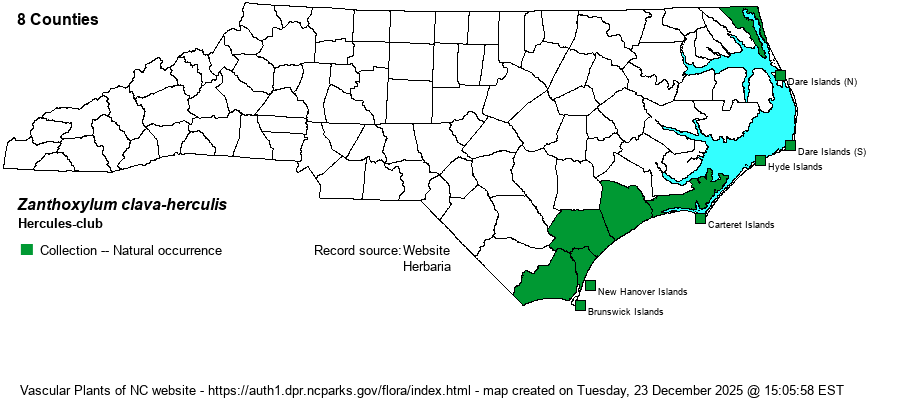| Author | L. | |
| Distribution | Strictly coastal, occurring in all coastal counties and most barrier islands, and found essentially only within a mile or two of salt water.
Ranges north to coastal VA, and south to southern FL and west to central TX and OK. It is not limited to the coast south and west of SC, occurring in much of the Coastal Plain.
| |
| Abundance | Infrequent to locally fairly common. Seldom is found in numbers, and always seems to be one of the less common woody plants in a given maritime forest or thicket. | |
| Habitat | In NC, it is strictly coastal, and is mostly found in the interior or margins of maritime forests, and on shell middens and adjacent margins of salt marshes. Rarely is it found on dunes. |
| Phenology | Blooms in April and May, and fruits from July to September. | |
| Identification | This is a small evergreen or very tardily deciduous tree, rarely a large shrub, growing typically to about 25-30 feet tall. It has alternate, pinnate leaves with about 11 leaflets, on average. The leaflets are lanceolate in shape. The species (and genus) is characterized by prickles along the leaf rachis, scattered among the leaflets, as well as stronger thorns on the twigs and especially on the trunks. Thus, any ash-like or hickory-like small tree in a maritime forest or in coastal habitats may well be this species; if it is spiny, it is certainly this tree. Do not grab the trunk of this tree, or you may get a painful stab or puncture wound! | |
| Taxonomic Comments | None, but it is rarely (and incorrectly) spelled as Xanthoxylum clava-herculis.
| |
| Other Common Name(s) | Southern Toothache Tree, Southern Prickly-ash, Pepperbark, Sea-ash, Tickle-tongue. It is also occasionally written as Hercules’-club.
| |
| State Rank | S2S3 [S3] | |
| Global Rank | G4 | |
| State Status | | |
| US Status | | |
| USACE-agcp | FAC link |
| USACE-emp | FAC link |

